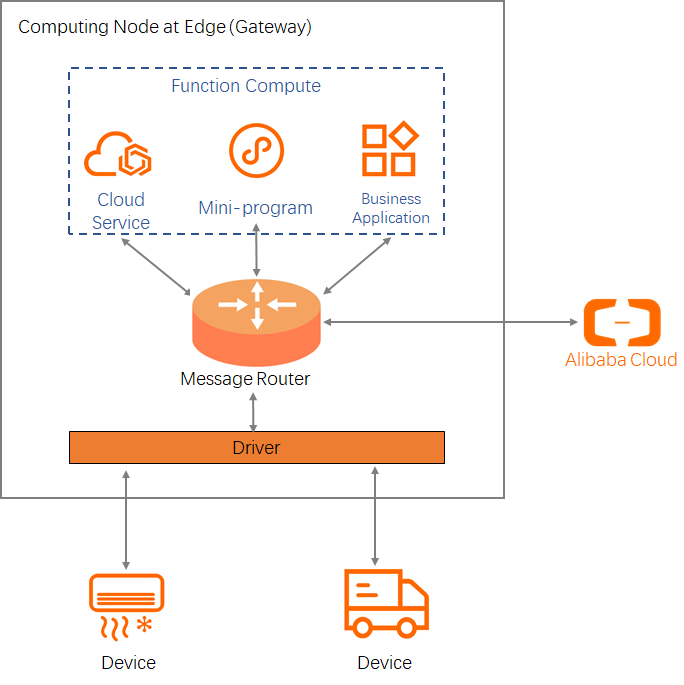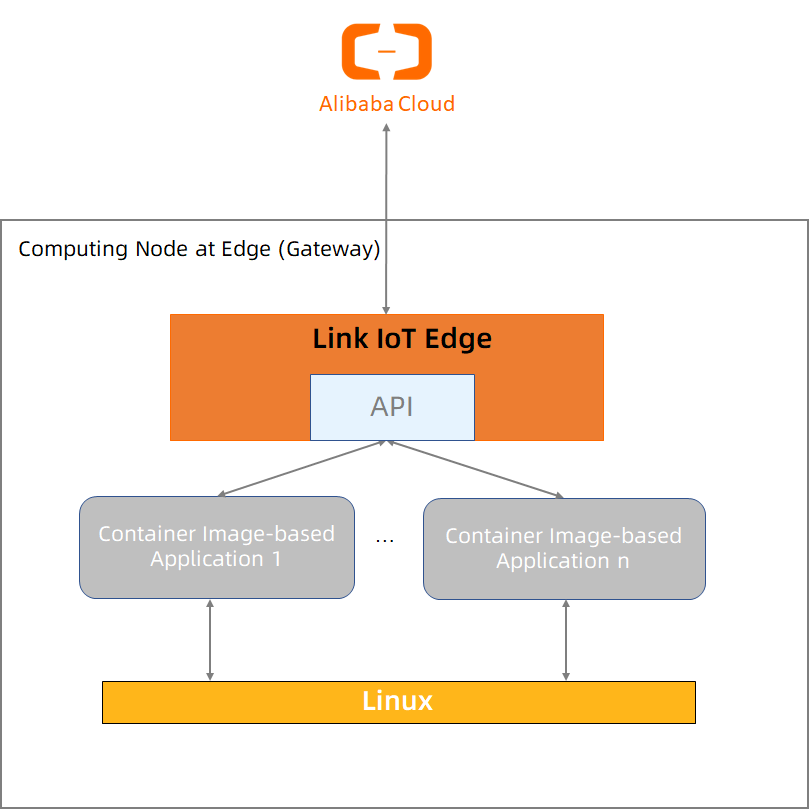Application management is a feature provided by Link IoT Edge. This feature allows you to manage versions and other configurations of edge applications in a centralized manner. Through Link IoT Edge, you can use either Function Compute or container images to create edge applications.
Function Compute-based edge applications
Function Compute-based edge applications are created by using the Function Compute service provided by Alibaba Cloud. You can develop code for the applications on the cloud, and run the code at the edge. Function Compute-based edge applications provide native support for the event-driven programming model of Function Compute. The applications also adopt a serverless computing framework. This framework allows you to focus on business logic development rather than basic operations such as program startup, message transfer, log query, and process keep-alive.
You can use Alibaba Cloud Function Compute to develop functions and then use the functions to create Function Compute-based edge applications. You can also use local files directly to create Function Compute-based edge applications. The local files must meet certain requirements. For more information about the requirements, see Function development guide.
Link IoT Edge Standard Edition does not support Python-based Function Compute.

Function Compute-based edge applications provide multiple features and benefits to facilitate management on edge devices.
- Benefits
- Flexible programming model: Function Compute-based edge applications support on-demand code execution, which is inherited from Function Compute. Edge applications of this type also support continuous code execution after you deploy the code to edge devices. Function Compute-based edge applications are applicable in development of device drivers and traditional programs that continuously run on servers.
- Real-time data collection and analysis: Functions are run on gateways at the edge. This improves the response speed by implementing data collection and analysis at nodes that are closer to data sources.
- Offline processing: Device data can be processed in local networks without being transmitted to the cloud. Therefore, devices can still work in cases of network disconnection.
- Features
- Code hosting on the cloud: enables you to add, delete, modify, and view code on the cloud at any time, and deploy and run the code on gateways without restarting the gateways.
- Program management at the edge: manages functions that are deployed on gateways, and supports features such as program running, service keep-alive, log query, performance monitoring, resource monitoring, and time-based triggering.
- API: provides an API for device-driven development and application development to reduce application development costs.
- Triggers When an event is triggered, Link IoT Edge calls the handler function in function code for processing. On-demand functions are run only when the event is triggered for the first time. The following list describes the triggers that are supported by Function Compute-based edge applications.
- Time-based triggers: You can specify a time point or time interval (for example, one minute) in the IoT Platform console to run the function at scheduled time.
- Message-based triggers: You can configure the function to run when a message is received from a device, the Function Compute service, a stream computing service, or another message source.
- Function callers: The Edge Gateway provides an API to call local functions. You can use an external program or Function Compute code to call a function.
Container image-based edge applications
Container image-based edge applications are developed based on the container technology. You can create edge applications from images in an image repository.
You can use image repositories that are provided by Alibaba Cloud Container Registry or public image repositories to create container image-based edge applications.
The lifecycle of container image-based edge applications is managed by Link IoT Edge. You can access the applications through the Link IoT Edge API from the edge.

For more information about container image-based edge applications, visit the official Docker documentation.
Procedure for using an edge application
- Create an edge application. For more information, see Create an edge application.
- Assign the edge application to an edge instance. For more information, see Assign edge applications to edge instances.